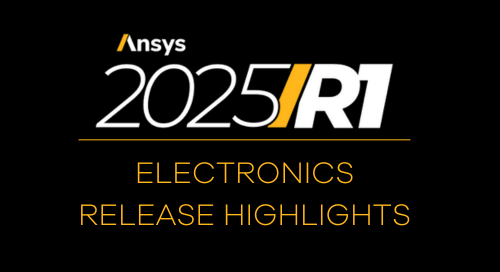Whether it’s automobiles, aircraft, servers, or vehicles used in space, system complexity is on the rise and so are the challenges associated with electromagnetic interference (EMI) and electromagnetic compatibility (EMC).
Several trends are driving this increased complexity, such as electrification of vehicles and systems, the growing demand for connectivity, and the miniaturization of electronics. Consider the electromagnetic environment in the average car today – Bluetooth, radio, GPS, and microwave signals are all passing through the vehicle. Every component can be either an emitter or a victim of electromagnetic interference.
On the supply chain side, the auto industry in particular has adopted new procurement strategies with an eye toward swapping in components from different suppliers. While this approach increases supply chain resilience, it also creates complexity and uncertainty from a design perspective.
It’s more critical than ever that design teams understand the environment in which their products will operate and EMC can’t be overlooked.
What’s Your Strategy for Managing Electromagnetic Effects?
EMC compliance testing is required before companies can ship a product. A study by Frost and Sullivan found that demand for EMC test equipment, software, and test services is growing at a compound annual growth rate of nearly 11% and the market as a whole was valued at nearly $4.5 billion in 2022.
EMC tests are costly and time-consuming. Yet, a recent survey of EMC test equipment and test lab providers found that around 50% of companies fail their EMC tests on the first pass and over one-third take at least three iterations to pass EMC testing for their products. For many companies, the default solution for EMC is to overdesign, over-shield, and then pray when they move into the testing phase.
A better solution is to develop a robust strategy for managing electromagnetic effects which includes digital simulation. Simulation is valuable because the earlier design problems are identified, the less expensive they are to fix. With digital simulation, it’s possible to avoid issues even before prototypes are constructed.
|
Four Questions to Ask About Your Organization’s EMC Strategy As you evaluate your organization’s approach to managing EMC, here are a few questions to consider:
|
Ansys EMC Plus and Ansys Charge Plus Support Proactive EMC Management
Ansys EMC Plus is a virtual EMC platform that supports EMI/EMC cable modeling and analysis and delivers a design-to-validation workflow for EMC. It is a dedicated solution for electromagnetic analysis of enclosures, platforms, and cable harnesses installed in complex products like automobiles, aircraft, and more.
With Ansys EMC Plus, it’s possible to:
- Analyze electromagnetic coupling through various cable shields to the conductors and wires within.
- Define and employ cable connectors which often possess different impedance characteristics than the cable itself.
- Terminate each conductor, wire, and shield within a cable harness with a variety of methods.
- Drive the cable system including pin voltages, electric fields, current sources, and plane wave sources.
The 2023 R1 EMC Plus introduces automated workflows which provide an easy way for mechanical or packaging teams to validate their designs. For example, with a single click, users can import a CAD model, automatically assign the materials and boundary conditions, set up a domain and excitation, and mesh it. Once the simulation is complete, users see a statistical view of the shielding effectiveness of their enclosure design.
With Ansys EMC Plus, time to value is short. Users can import large, complex CAD models. The system supports fast execution, thanks to a forgiving voxel mesh and hybrid solving based on time domain 3D, multi-conductor trans line, and Nexxim circuit solvers.
Ansys Charge Plus focuses on electrostatic discharge (ESD) events. It combines electromagnetic solvers, fluid solvers, and particle physics solvers to provide an easy-to-use Multiphysics simulation solution.
Ansys Charge Plus targets four challenges:
- It performs accurate charging analysis to determine when, where, and how an electric arc problem is created since the undesirable EMI effects and material degradation are difficult to anticipate.
- It manages the consequences of electrostatic discharges in air and solid dielectrics, which historically require numerous and complex simulation tools with steep learning curves.
- It predicts charge accumulation on satellites and space platforms – a complex task that requires knowledge of plasma and material physics.
- It prevents catastrophic failure of satellites due to discharge events which must be tackled in the design phase, as testing in space is nearly impossible.
Examples of Charge Plus EMD applications include arcing in high voltage systems, high voltage switches, power line arcing, lightning attachment modeling, PCB flashovers, solid dielectric breakdown, and ESD gun – IEC 61000 standard.
|
Unique Solutions Based on Integration Between Ansys Charge Plus and the Ansys Portfolio of Solutions
|
Conclusion
With Ansys EMC Plus and Charge Plus, teams can create robust simulation strategies for EMC which reduce costs through design optimization, minimize expensive test failures, increase product safety, and reduce company liability.
Contact Rand Simulation to Get Started Today
Ready to get started with Ansys EMC Plus and Ansys Charge Plus? We're here to help. Contact us for a consulting quote (if you're looking for us to run your simulations) or if you're interested in purchasing this EMI/EMC software.
About the Author
Follow on Linkedin More Content by Conrad Magalis








